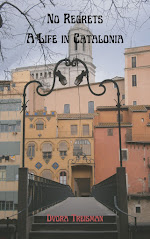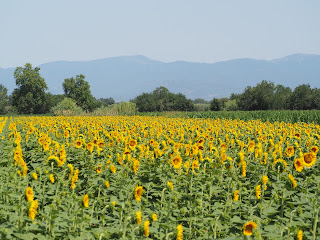There are several interesting Catalan Christmas traditions both sacred and profane. First, foremost, and most profane is the caganer – a small peasant figure typically dressed in black pants, a white shirt, and a Catalan peasant cap (a barretina) who appears in most nativity scenes, at least those not in churches – who is squatting and shitting while smoking his pipe or, in a more modern version, a cigarette. Caganer means shitter. There seems to be no documented origin to the caganer, except to say that he has been around longer than anyone can remember. Robert Hughes talks about him in his excellent book about Catalonia, Barcelona, and Joan Miro painted a little squatting figure into his famous 1922 work, The Farm. The caganer represents a natural activity and brings the whole miraculous concept of the nativity down to earth. Nowadays the caganer need not be a traditional peasant. Figures can be found (at Christmas fairs and year round on the internet) representing famous people such as the president of Catalonia or other political figures (loved and unloved), many of the soccer heroes, nuns, priests, the Pope...
Then there is the Tió de Nadal, a Catalan mythological character who also appears in Mallorca, Occitania, Andorra, Valencia, and Aragon. The name means Christmas Log and is related to the German Christmas tree and the British Yule log. But Wikipedia notwithstanding, I have never heard it called a Tió de Nadal; I’ve only ever heard it called the Caga Tió, caga, as in Caganer. Once just an unadorned log, now it has legs, a face, and the same little peasant cap (the barretina) as the caganer. It is a hollowed out log that is stuffed with small presents. On Christmas Eve, after having taken care of it – fed it and kept it warm with a blanket for several days – the children beat it with a stick while singing a song, imploring it to poop the presents it is holding within. These are small presents, candies and little toys. Bigger presents are for Kings.
hazelnuts and nougats,
do not shit herrings,
they are too salty,
shit nougats
they taste better.
Shit, tió,
almonds and nougats,
and if you don’t want to shit
I’m not sure I have ever met a Catalan who attends church regularly or who even attends the midnight Christmas Mass. But there are those who do attend the Christmas Mass in order to hear a special Christian liturgical drama sung to Gregorian chant. This is the Song of the Sibyl which has been performed in Mallorca, Alghero (Sardinia), and some Catalan churches almost uninterruptly since medieval times. Nothing of Santa Claus, presents, or shitting, it is a prophecy that tells of the apocalypse. For hundreds of years women were not allowed to sing in church so even though a Sibyl is a woman, the song would be sung by a boy. Now it is sung by either a woman or a boy. It it sung a capella with instruments playing between one verse and the next. The singer wears a tunic, and usually also a cape, and carries a sword which is held in front of his or her face until the song is completed when a cross is drawn in the air.
The chant was originally sung in Latin, later adapted to Provençal, and then to Catalan by the end of the 14th century. The Song of Sibyl was abandoned throughout Europe when it was forbidden by the Council of Trent (1545-1563). But it was restored in Mallorca in 1575 and there it still has the strongest presence although it is also becoming popular now in Barcelona and other towns in Catalonia. The performance of the Song of Sybil in the churches of Mallorca was declared an UNESCO Intangible Cultural Heritage of Humanity in 2010.
Performance in the Barcelona Cathedral.
https://www.youtube.com/watch?v=GmqiTQfVNGw












.jpg)























.JPG)























